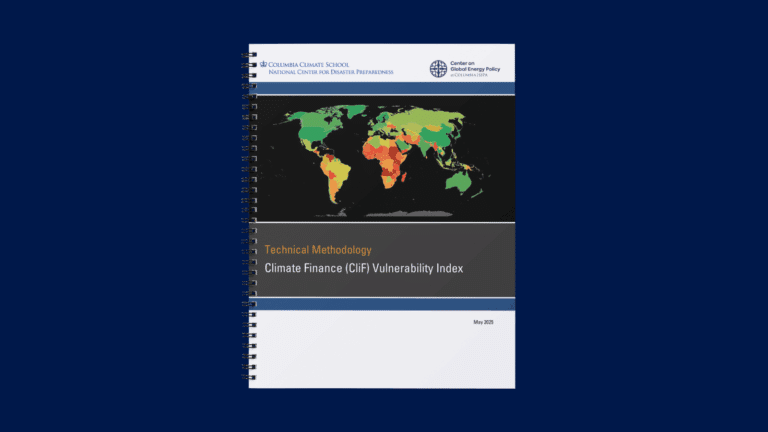This roundtable report reflects the authors’ understanding of key points made in the course of the discussion. It does not necessarily represent the views of the Center on Global Energy Policy. The summary may be subject to further revision.
Contributions to SIPA for the benefit of CGEP are general use gifts, which gives the Center discretion in how it allocates these funds. More information is available on our Partners page. Rare cases of sponsored projects are clearly indicated.
The authors would like to thank Interim Director Thomas Trebat, Carla Magri, and Christian Molinari of Columbia Global Centers | Santiago for their invaluable partnership in the organization of this roundtable discussion. We are also very grateful to Diego Rivera Rivota for his help in the organization of this event and on the preparation of this report. We would also like to thank Kevin Brunelli, Clarisa Marambio, Christian Molinari, and Josefa Muñoz, who provided very valuable notes. Special thanks to Juan Carlos Jobet and Tom Moerenhout for their unconditional support in the realization of this event. Our appreciation also goes to CGEP’s publications team for their editorial work.
On November 9, 2023, the Center on Global Energy Policy at Columbia University SIPA, in partnership with Columbia Global Centers | Santiago and the Center on Business and Society at the Business School – Universidad Adolfo Ibañez in Chile, hosted a private roundtable under Chatham House rule on environmental, social, and governance (ESG) challenges in Latin America’s mining sector, which is expected to play an increasingly important role in sourcing some of the critical minerals needed for the energy transition. Bringing together global and local financial investors, academics, representatives from mining companies and multilateral organizations, sustainability experts, and other stakeholders, the roundtable explored how ESG factors may impact the region’s ability to fulfill this role and how ESG considerations can be integrated into mining practices in the region at a corporate and government policy level. This workshop report summarizes key points that emerged from the dialogue.
1. The energy transition represents a unique opportunity for Latin America’s mining sector, but ESG challenges may prevent the sector from capitalizing on it.
The roundtable opened with a discussion of the unique opportunity that the energy transition represents for Latin America’s mining sector, which is a major source of revenue for some countries, with the region accounting for about 40 percent of the world’s copper supply and about 36 percent of its lithium supply.[1]
One participant stated that such revenues from mining activities in the region could be 1.5 times higher by 2030 given expectations that demand for critical minerals will grow more than threefold between now and then. Another participant added that investment in the sector will need to ramp up significantly to satisfy that demand.
A different participant suggested that the energy transition represents the greatest opportunity in decades for the mining sector in Latin America. This participant added that the emergence of this opportunity has boosted the sector’s legitimacy, but also comes with major responsibilities. The participant elaborated that ESG is not something companies can do on the side, but should be at the core of their business practices.
One participant mentioned that ESG risks can lead to less investment than needed for the energy transition, potentially impacting government revenues. Another participant detailed the many ways in which ESG risks could prevent the region from capitalizing on the energy transition, whether by acting as a barrier to investment, causing supply disruptions through tailings accidents, impacting the social license to operate, or jeopardizing access to markets, particularly the EU given its higher ESG standards.
A different participant noted that the region is facing the unique challenge of balancing the pressure to develop mining resources with doing so sustainably, to mitigate opposition among the public broadly and, more importantly, within the local communities that would otherwise be impacted.
2. ESG challenges can be exacerbated by the local institutional setting in which mining operations occur.
In Latin America’s mining sector, ESG challenges are also linked to the local institutional setting in which mining companies operate. One participant noted a gap between local mining regulations and more demanding international industry standards, with the largest regulatory gap related to water usage. Among the institutional challenges discussed by this participant was the lack of bidding processes akin to those that exist in the oil and gas sector. As the participant pointed out, this potentially allows actors with low ESG standards to obtain first rights to operate mining resources, to the detriment of the sector’s reputation among local communities.
The participant called attention to the tendency of new mining countries to have lower ESG standards than mature mining countries. As this participant pointed out, even if regulations existed in these countries, there is often insufficient trust from the local community for them to be enforced. Another participant observed that enforcing standards requires allocating sufficient resources to government agencies. A different participant argued that providing Latin American countries with technical and policy assistance for creating and maintaining adequate institutional settings will attract responsible and sustainable investment.
3. Understanding ESG risks in Latin America’s mining sector starts with reporting, but the latter is insufficient given that such risks exist at the mine level and are not always captured in ESG reports.
The roundtable discussion touched on many challenges related to ESG reporting. According to one participant, adherence to such reporting is uneven in Latin America because the region contains many different types of mining companies, including global companies, local companies, and state-owned companies, with smaller local companies exhibiting much less transparency in reporting.
Other participants stated that some of the most critical ESG issues in the Latin American mining sector might not even be captured in companies’ ESG reports because such reporting takes place at a corporate and not an asset (mine) level.
For some participants, the level at which ESG risks are measured and reported impacts the efficacy of stakeholder management. Others agreed that the materiality of ESG is wide-ranging and asset-specific, creating a tension between information provided at an aggregate level and that provided at a local level. This participant referred to work being done by standard setters such as the Initiative for Responsible Mining Assurance (IRMA), the Copper Mark, and the International Council of Mining and Metals (ICMM) on mine certifications and standards, and how to make them accessible to civil society and local stakeholders. The participant stated that investors might focus on ESG metrics that are comparable across companies, but local stakeholders are more interested in how mining projects can benefit a local community, which may not be as valuable to investors and thus could be overlooked in ESG reporting.
One participant noted that transparency sometimes scares companies and brings them to a standstill. However, this participant stated that the potentially large impact the mining sector can have on local communities demands progress in ESG mining standards and reporting in the region, which can help to overcome mistrust. Emphasizing the importance of the latter, another participant argued that “mining is guilty until proven innocent.” For this participant, building trust means operational excellence, competency (“doing what you say”), and integrity (“saying what you do”).
Several participants cited recent social tensions in Panama around the development of mining resources—specifically publish backlash against a copper mine contract with First Quantum Minerals, the supreme court’s ruling about the unconstitutionality of the contract, and its eventual cancellation[2]—as an example of the importance of building trust and making progress on ESG standards in the region.
One participant pointed to the number of standards and initiatives around sustainability and ESG—about 150—and found it problematic that most were industry-led, stating that diversified funding models are key for initiatives to be seen as trustworthy. This participant suggested that best practices are to follow a rigorous multi-stakeholder governance model, conduct external audits, and engage local stakeholders, with results made available to the public.
4. Investor engagement with mining companies is key to assessing progress with decarbonization and with the management of other risks like social license to operate.
Many of the financial sector participants noted that ESG considerations factored into their investment decisions. One participant mentioned that, when making investment decisions, they check to see that the sourcing of minerals is aligned with the goals of combating climate change.
Another participant commented that ESG considerations have long been a factor in investment decisions, but are now becoming more explicit and financially material due to the increased scrutiny that mining companies attract. In the view of this participant, ESG risks are amplified in Latin America because the region’s mining activities take place in biodiversity hotspots.
This participant argued that the materiality of ESG issues varies by mine site location, type of mineral extracted, and who assesses them (global investors vs. impact or ethical investors). Some investors ask almost exclusively about energy and carbon intensity while others are more concerned about water supply and its impact on the local community.
Many participants from the financial sector viewed ESG data as essential to monitoring and tracking progress with ESG and sustainability goals. One investor described how their organization incorporated ESG metrics into its investment process. The participant specified that environmental considerations account for 40 percent of the scoring in their organization’s ESG model, and that among the environmental factors considered are water usage, carbon emissions alignment and progress toward net-zero targets, green capex, and handling of material waste.
Another participant commented that measurement is one thing and engagement is another. Some of the investor participants in the roundtable placed a high value on engagement as a way to understand companies’ transition strategy, operating risks, and risk mitigation strategies. One participant mentioned, for example, that investors also engage with companies to assess how they keep their license to operate.
One participant suggested that investors seek engagement with companies to support higher sustainability standards and decarbonization strategies, but some investors prefer to pursue that engagement within initiatives such as Climate 100 and Nature 100, which in the view of this participant represent integral engagement tools.[3]
5. Environmental risks in the mining sector depend on the type of commodity and how it is extracted and processed, with water management seen as a key environmental risk.
One participant stressed the point that how minerals are extracted and/or processed is important in assessing environmental performance across companies and regions. As an example, the participant pointed to the water intensity of different methods of extracting lithium, with lithium extracted from hard rock in Australia a much more water-intensive process than lithium extracted from brine pumping activities in Chile and Argentina. The participant also raised the example of nickel processed in Indonesia from laterite, which has higher carbon emissions than nickel sulphate because it is more energy-intensive (and is powered by coal). For this participant, Latin America’s relatively clean electricity matrix gives the region an advantage and provides it with opportunities to develop other metals like bauxite and aluminum in a less carbon-intensive way.
Many participants raised the issue of water stress levels in Latin America’s mining sector, particularly in Peru and Chile. One participant underscored the critical impact of the water issue on local communities, suggesting how environmental performance can affect social license to operate.
After one participant pointed out that water stress in Latin America’s copper production is high compared to other regions, such as Southeast Asia, some participants emphasized that Latin America’s copper sector could use seawater as an environmental tool, particularly in countries like Chile where mining occurs in zones with water shortages. Another participant pointed out that Chile has 11 desalination plants in operation and 15 more under construction, with expectations to double seawater consumption in 10 years. While seeing this growth as a positive development, this participant underscored that policy coordination with the private sector about desalination plants could have resulted in fewer, but larger, desalination plants, which could have made operations more efficient, less power-intensive, and less polluting.
One participant echoed previous statements related to data transparency as a way of mitigating ESG— particularly environmental—risks. However, this participant also proposed setting baselines early on in the project for different environmental metrics like water management and tailings compliance.
6. Decarbonization is still at the heart of addressing environmental risks in the region’s mining sector.
According to one participant, Latin America’s mining sector compares favorably with the rest of the world on environmental performance, so improving environmental performance in the region could be a low-hanging fruit.
Another participant argued that while the mining sector in Latin America might have a lower carbon footprint given the relatively cleaner electricity matrix, greenhouse gas emissions from the region’s mining sector do matter at a country level. The participant cited the case of the Chilean mining sector, which represents 16 percent of Chile’s total emissions. The participant argued that this makes carbon neutrality an essential target for this sector in Chile, where over 95 percent of copper, silver, and molybdenum supply are covered by net-zero standards. In this participant’s view, companies must not only present decarbonization roadmaps but also deliver on them, suggesting that a roadmap for decarbonization in the sector requires first and foremost investing in innovative clean solutions.
As another way of managing environmental risks in the region, a different participant proposed incorporating climate and environmental risks into contracts, a move that could help to compensate for a lack of adequate local laws in certain countries in the region. The participant suggested, for instance, that contracts could address adaptation issues by requiring that companies conduct climate assessments and comply with national adaptation plans and standards. According to this participant, such contracts could include provisions on water usage, wastewater treatment, desalination, and tailing dams, as well as mitigation provisions requiring companies to set targets/reduce greenhouse gas emissions and use forestry and biodiversity solutions rather than offsetting emissions. This participant also suggested requiring companies to take insurance policies related to climate and environmental risks, incorporating the orderly closure of mines into mining contracts, and adopting circularity—such as reducing waste at mining sites and repairing, harvesting, and reusing metals—into their operations, which can open business opportunities while reducing waste and emissions.
7. The sector’s social license to operate is about developing and maintaining strong stakeholder engagement from the beginning of the project.
The discussion of social responsibility addressed many aspects of mining projects, with some participants offering lessons learned. These participants concurred that one of the most important lessons is that stakeholder engagement with local communities starts at the beginning of a mine project and must be maintained throughout its lifecycle, which in many cases is about 40 years. One participant added that it is also important to define and communicate procedures for mine closures as early as possible.
According to another participant, developing good governance on social performance is key to building trust within the community. The participant observed that this includes showing respect for the community’s vision and building upon its local knowledge to reduce the impact of mining operations. Several participants raised the idea of co-designing local initiatives that are of value to the community as part of good social governance. One participant argued that lessons learned from mistakes can be even more valuable. As examples of such lessons, the participant mentioned saying sorry, communicating risks, maintaining dialogue when problems arise, and finding solutions in partnership with the community. The participant suggested understanding operations in terms of minimizing local impact and not exclusively maximizing efficiency.
Another participant mentioned that achieving effective stakeholder engagement throughout the life of a project requires not only developing a sound methodology and effective evaluation, but also building a local team that includes individuals from local communities and empowering that team to lead the project effectively.
8. Within companies, the “S” in ESG entails safe operations, but also safe environments for a diverse workforce and the elevation of standards across the value chain.
One participant pointed out that part of “S” is creating safe environments for the workforce. This participant saw operational safety not only as an ethical principle, but also as a key to business continuity and an important indicator of discipline in the production process. Safety, this participant argued, was not a cost but a core aspect of operational excellence monitored by investors and authorities.
According to another participant, safety also encompasses how companies manage diversity, equity, and inclusion, which starts with inclusive leaders. This participant saw a direct relationship between diversity and performance. Another participant mentioned that while diversity, equity, and inclusion are a cultural challenge for all mining companies, they might be an especially important challenge for local mining companies.
One participant stated that ESG metrics are about not only the company’s standards but also their supply chains. This participant argued that companies need to work with local providers to raise their ESG standards, which might not be as high as those of the global companies they are serving or of global suppliers.
9. Governance at the company level starts with ensuring the board is competent in terms of ESG risks.
While the mining sector’s ESG focus has been on “E” and “S,” some participants argued that “G,” or governance, is key to addressing both effectively.
One participant mentioned how governance can become a competitive advantage, and how strategic the board of directors is in this process. This participant noted that board composition must go beyond sectoral and technical skills to include ESG competence, particularly given that reputational risks are high in the mining sector and that these risks impact the value of a company. Regarding key governance considerations, this participant raised transparency and disclosure, anti-corruption practices, human rights, and data protection in a company’s commercial practices and throughout its value chain. Another participant agreed that corruption risks, in particular, are a major source of concern to investors.
10. Volatile mining rents, stable contracts, and government desire for downstream diversification might imply governance challenges and trade-offs in terms of mobilizing investments.
While the roundtable discussion concentrated on the ESG risks of companies operating in Latin America’s mining sector, one participant discussed the risks to thecompanies themselves, particularly in light of the region’s variable investment rules.
This participant also discussed the governance challenges posed by mining rents, not only in terms of how these rents are allocated but also in terms of the fact that mining revenues fluctuate with the rise and fall of mining prices. The participant added that while distributing rents to local communities facilitates mining operations, it may impact the national government due to a lack of clarity about government revenues.
This participant also mentioned the trade-offs that come with governments pushing downstream diversification to add value in the sector. This participant argued that the desire of governments for more local content, more employment, and higher-paying jobs could limit the region’s ability to attract investment in its mining sector given that these are very long-term projects with very volatile revenues.
This participant also stated that state-owned mining companies in Latin America are relatively uncommon, but the governance of these state-owned enterprises is complicated by their often low ESG standards compared with their private counterparts.
In closing, the discussion centered on the many ways in which ESG factors are impacting Latin America’s mining sector, how these risks can be addressed, the relevance of ESG disclosures and transparency for all stakeholders including investors, and the relevance of local institutions and government policy in addressing these challenges.
Acknowledgements: The authors would like to thank Interim Director Thomas Trebat, Carla Magri, and Christian Molinari of Columbia Global Centers | Santiago for their invaluable partnership in the organization of this roundtable discussion. We are also very grateful to Diego Rivera Rivota for his help in the organization of this event and on the preparation of this report. We would also like to thank Kevin Brunelli, Clarisa Marambio, Christian Molinari, and Josefa Muñoz, who provided very valuable notes. Special thanks to Juan Carlos Jobet and Tom Moerenhout for their unconditional support in the realization of this event. Our appreciation also goes to CGEP’s publications team for their editorial work.
[1] International Energy Agency, “Latin America Energy Outlook 2023,” 2023, https://www.iea.org/reports/latin-america-energy-outlook-2023.
[2] Elida Moreno, “Exclusive: Panama May Slash GDP Growth View Due to Suspension of First Quantum Mine,” Reuters, December 4, 2023, https://www.reuters.com/world/americas/panama-may-slash-gdp-growth-view-due-suspension-first-quantum-mine-2023-12-04/.
[3] See websites for Climate 100 (https://www.climateaction100.org/) and Nature 100 (https://www.natureaction100.org/).






